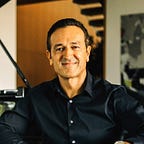Why Generative Art Appeals To Our Deepest Emotions
By Hernan Lopez
“I don’t get it,” said the skeptical voice as he looked around the room.
About 100 of us had gathered in Los Angeles to celebrate the new digital art renaissance. Artists, collectors and friends were socializing, admiring and taking photos with groundbreaking generative artwork by the likes of John Gerrard, Monica Rizzoli, Jen Stark, SnowFro and Leo Villareal. In addition to generative art, there were stunning 1:1s by Refik Anadol, Luna Ikuta, Zach Lieberman, Diana Sinclair and Justin Aversano, all exhibited in the full glory of our 4’x4’ displays. “Warhol thinks Pop3” by Hackatao gave a nod to the Pope of Pop. They shared the room with paintings by Richard Serra, Oscar Murillo and Sonia Gechtoff, and to most people’s eyes, it was a moment of delight.
But the skeptic, who didn’t realize I overheard him, was dismissive of it all. And I get why he didn’t get it. In the early days, many didn’t get Warhol, who was ahead of his time.
When I started to collect art, one of the first, and most important, lessons I learned came from sought-after art advisor Barbara Guggenheim: “once an artist develops a critical mass of collectors, that community is invested in the artist’s success.” This, in turn, makes each individual artwork as well as the artist’s entire body of work more valuable over time.
From a psychological perspective, this makes a lot of sense. All humans hold two very strong but at the same time conflicting desires: belonging and territory. We want to be part of a community while maintaining our individuality.
These instincts trace back to our ancestors. In the Stone Age, you needed to be part of a tribe in order to survive — no community meant hunger and death.
But at the same time, we have a deeply held sense of territory. Our identity, our personality, our possessions — we all want something that clearly differentiates us from the tribe. That’s a big part of the reason why we like the sound of our own name, why we dress up, why we buy cars, houses — and why we collect artwork.
Traditionally, artists’ ability to create that community had been limited by time, among many other factors. You could only paint so fast.
Warhol stood out for many reasons, the most salient being his unique way of incorporating pop culture into art. He also stood out for being prolific: a pioneer of the silk screen technique, he would go on to create over 9,000 paintings and sculptures. He called his studio The Factory.
We shouldn’t be surprised that many questioned whether a painting created via silk screen, of which there could be hundreds, could ever be worth as much as a painting that had taken months to complete. Sound familiar? In fact, the opposite happened: the Warhol community grew and grew, and every time a collector saw a new Marilyn Monroe on someone else’s wall, they wanted their own Marilyn Monroe more, not less. Just this year, “Shot Sage Blue Marilyn” became the most expensive 20th-century artwork ever sold, when Christie’s auctioned it for $195m.
Generative art has been around almost for as long as those Marilyn Monroes, but it’s been supercharged in the last two years. One of the most valued collections, “Fidenza” by Tyler Hobbs, was recently estimated to be worth $220m. Of course, with success comes renewed scrutiny — should we treat art created by code in the same way we treat art created by a paintbrush?
Coming back to that gathering on a breezy November night: nearly everyone in the room was excited about the past, present and future of digital art. Some were excited about being part of the Chromie Squiggles community, or the Ringers community, while especially proud of their own Squiggle or Ringer. Most weren’t wondering whether the art was created by a paintbrush, an Apple pen or code — it all started from the heart and the skill of an artist.
Even that one skeptic, to his credit, chose to come and see what it was before deciding it was not for him. Art is subjective. You can “get” one artwork but not another — just like we all “get” one song, one book or one poem, but not the next.
As it relates to digital art, however, the trend is clear. Increasingly, not only collectors but also museums are embracing it, as reported recently by the NY Times. And fewer and fewer people question whether art created by code is art. Of course it is. Just like few question whether silk screen paintings, or paintings finalized by artists’ assistants are worth as much — just ask Damien Hirst. Instead, I chose to join the collectors and artists who get excited about how code can advance art — from generative to interactive, from programmatic to AI. And those who get excited about enjoying art in real life, as the digital art renaissance is just getting underway.
Hernan Lopez is the Co-Founder of Danvas, a startup bringing digital art into the real world through museum-quality displays. Hernan is also the Founder and Chairperson of the Hernan Lopez Family Foundation, dedicated to helping increase diversity in leadership. Previously, Hernan was the Founder and CEO of Wondery, one of the largest podcasting publishers, acquired by Amazon in 2021.
Connect with Hernan on Twitter to learn more.
